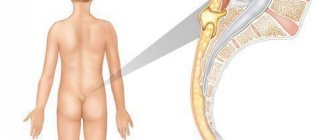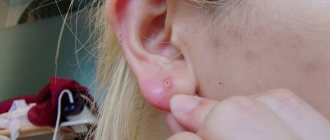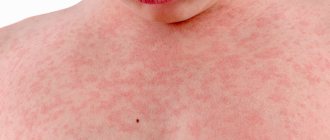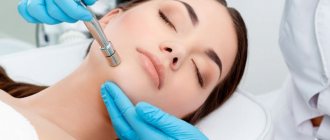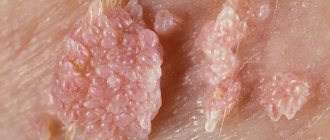In most cases, a pimple on the anus signals the development of serious pathologies. If acne appears near the anus, it is recommended to visit a proctologist to determine the cause that provoked this phenomenon.
If acne appears, it is important to visit a doctor immediately
What it is
Anal pimple is not an independent disease, but in most cases it is a manifestation of symptoms of some other disease. Often pimples that appear around the anus do not indicate diseases of the intestinal tract.
There are different types of anal acne:
- Primary acne occurs as a result of local causes. For example, when rubbing against clothing, when the perineal area overheats. Another name is idiopathic.
- Secondary acne is always a sign of another disease. They can be a manifestation of allergies, diseases of the rectum and even diabetes.
The formation of anal pimples brings a lot of inconvenience to a person. Their occurrence is almost always accompanied by a set of symptoms, including itching and burning in the anal area. These accompanying unpleasant symptoms can occur even in the absence of irritating factors (for example, friction from clothing).
Normal, from the patient's point of view, acne can represent various skin formations, the exact differential diagnosis of which can only be carried out by a doctor.
Pimples near the anus can be in the form of:
- nodules;
- papules;
- spots;
- plaques;
- scales;
- bubbles;
- seals;
- ulcers
The type of pimple and the severity of its presence near the anus depends on the specific reasons, which we will discuss below.
Genital herpes
The herpes simplex virus is divided into two types, different in their characteristics:
- First type. Most often it appears on the lips and is the cause of colds. If personal hygiene rules are not followed, virus particles are transferred to other parts of the body: eyelids, under nails, groin, mouth. A pimple near the anus may appear as a result of scratching the intimate organs with dirty hands after touching the lips.
- Second type. Characterized by rashes in the genital area, on the perineum, and in the anus. The skin lesions sometimes affect the buttocks, thighs and lower back.
Causes
The occurrence of anal acne can be caused by many factors: from a harmless lack of proper hygiene to cancer.
Let's take a closer look at the possible causes of anal pimple:
- Lack of sufficient hygiene of the anal area can lead to an inflammatory process. Since the skin in this area is quite delicate, microcracks may periodically form on it. When various types of bacteria enter them, inflammation occurs and acne forms.
- Boils and carbuncles - occur when an infection enters the cavity of the hair follicle. Boils are characterized by single purulent pimples around the anus, with a hard core in the center. When such anal pimples merge, a carbuncle is formed - extensive inflammation in the subcutaneous tissue, which requires urgent medical attention.
- Allergic manifestations can be caused by the use of new hygiene products or synthetic underwear. Allergic anal acne can also be a manifestation of an immune response to any internal causes in the body.
- Infectious diseases such as chickenpox or rubella can contribute to the appearance of anal acne. However, the upper parts of the human body are primarily affected; acne around the anus appears later.
- Genital warts and papillomas are manifestations of a viral infection. They grow very quickly in size and quantity. Never presented in a single copy.
- The herpes virus is characterized by the appearance of watery pimples in the anal area. This phenomenon is usually accompanied by itching and burning in the genital area. From the moment of infection until the appearance of the first blistering rashes, this disease is asymptomatic. Later, herpetic pimples can burst and become covered with crusts, causing severe itching in a person. If hygiene is not maintained sufficiently, a bacterial infection may occur. In this case, the healing process of the blisters is delayed.
- Syphilitic lesions in the anal area manifest as painful pimples more than 5 mm in diameter. Such pimples have a specific ring shape and are called chancre.
- A rectal fistula looks like a communication between the rectal cavity and the skin around the anus. Fistulas can vary in diameter and length.
- If an anal pimple occurs directly inside the anus, then most likely it is a hemorrhoid. They are usually painless and are discovered by the patient only during hygiene procedures. Pain with such nodes occurs when it is thrombosed by blood clots. Hemorrhoids can bleed and cause discomfort during bowel movements.
- Rectal polyps are growths of the inner lining (epithelium) of the rectum. If the polyp is large, it is “born” from the anus and can be mistaken for a regular pimple. The danger of polyps lies in two points. Firstly, they often become malignant, that is, the epithelial cells of the polyp degenerate into cancer. Secondly, when a polyp is pinched by the sphincter of the rectum, its necrosis - death - can occur.
In addition to the above reasons, an anal pimple can be a manifestation of a malignant (rectal cancer) or benign (atheroma, dermoid cyst) neoplasm. In such cases, pimples tend to grow and may bleed.
Read how to get rid of internal acne on your face. Facial cleansing from acne by a cosmetologist. More details here.
What types are there?
Manifestation of genital herpes
Discomfort and a small rash in the anus can be a signal of genital herpes.
A pimple near the anus is often a consequence of the activity of the herpes virus, which almost every person has. With pathology, white sores form near the anus, which are very itchy and have a negative effect on the tissues of the genital organs. In women, the pathology is often simultaneously accompanied by herpetic lesions of the vagina. The disease can be recognized by the following signs:
- redness and burning sensations in the affected area;
- the appearance of pasty discharge from the anus;
- pain syndrome;
- local increase in temperature;
- the formation of pimples containing exudate;
- erosive areas in which cracks are visible that begin to bleed during bowel movements;
- the appearance of ichor from the anus;
- spasms in the rectum.
What causes anal warts?
If it itches between the vagina and anus, this may indicate the formation of condylomas. Often a person notices that many pathological rashes appear at once, which are associated with infection with the human papillomavirus. The strain that causes acne in the anal area is most often transmitted through sexual contact. It is possible to distinguish warts on the anus by the following signs:
- With anal papillomas, an unpleasant odor is felt.
uneven top layer with tubercles and folds; - the base of the pimple is thin and soft;
- colored flesh-colored, pinkish or slightly reddish;
- can be single or formed in groups;
- cause itching and discomfort;
- easily susceptible to injury;
- localized on the inside and outside of the anal canal;
- discomfort during bowel movements;
- bleeding;
- unpleasant smell.
Features of boils
The resulting purulent pimples around the anus are a consequence of the formation of a fistula. Chronic paraproctitis, against the background of which purulent-hemorrhagic fluid is released in pathological canals or fistulas, can affect the disorder. Women often face this problem after childbirth, which is associated with gynecological injuries. Such pimples in the anal area are usually divided into several types, presented in the table.
| Variety | Peculiarities |
| Full | Pimples are localized in the walls of the rectum |
| The anal or perineal area is affected | |
| Incomplete | No access to the surface |
| Pimples appear on the inside | |
| Often temporary | |
| Transsphincteric | Scars and purulent pimples form on nearby tissues |
| Intrasphincteric | Rapid onset of inflammatory response |
| Mild scarring |
Symptoms characteristic of a cyst
The resulting pimple in the anus may be nothing more than a cystic formation. This type of tumor is benign and is most often localized near the anus. The cyst contains soft contents, which may also contain hairs. If a cyst has formed, even in the absence of unpleasant symptoms, its surgical removal is required. When the tumor grows to a large size, it can become inflamed and painful.
What are polyps associated with?
With frequent constipation or diarrhea, polyps may develop.
If multiple pimples appear near the anus, this may signal a similar disorder. The rashes are large and in rare cases cause pain. Pimples on the anus cannot be cauterized; they require surgical removal. The color of acne can be bluish or reddish. If the pathology is not treated in a timely manner, the pimples grow and blood is released from them. An advanced course threatens to degenerate into a cancerous tumor. The progression of polyps in the anal area is influenced by the following negative factors:
- bowel abnormalities;
- regular constipation or diarrhea;
- unbalanced diet, in which there is an excess of junk food.
The clinical picture of polyps differs depending on the types of disorders presented in the table:
| Type | Character traits |
| Fibrous | Consists of connective tissue |
| Rarely progresses to oncology | |
| Villous | Small pimples resembling papillae |
| Bleeds often | |
| Hyperplastic | The size of polyps does not exceed 5 mm |
| Predominantly benign course | |
| Adenomatous | Are harbingers of cancer |
| Mixed | Acne that combines several types of polyps at once |
Perirectal fistula
A fistula in the anus may bleed.
When there is deviation in the anus, a white pimple is formed, inside of which there is purulent fluid and a rod. Often, pus leaks from the tumor, spreading to healthy tissue. The deviation may appear against the background of exacerbation of paraproctitis. The disease can be recognized not only by acne, but also by other clinical signs:
- a wound that appears in the anal area;
- purulent discharge from the wound;
- bleeding;
- unpleasant odor;
- pain and redness of the damaged epidermis;
- difficult bowel movement;
- sleep problems;
- increased irritability;
- impaired urination.
Diagnosis of the disease
First of all, to diagnose the causes of an anal pimple, a proctologist will examine and palpate this formation. He also needs to find out the patient’s history of the disease: how long ago the pimple formed, what events preceded it, and whether this happened before.
If the anal pimple is localized in the area of the walls of the anus, then a digital rectal examination will be required. In this case, the specialist will evaluate the size of the formation, its adhesion to surrounding tissues and consistency.
If necessary, the doctor may prescribe the following instrumental examination methods:
- ultrasound examination of the abdominal organs;
- irrigoscopy - x-ray examination of the intestine;
- Rectoscopy is an endoscopic examination of the rectum.
To assess the general condition of the body, the patient is also prescribed laboratory examination methods: a general blood test. Using this analysis, you can identify the inflammatory or allergic cause of pimple.
If the herpetic nature of an anal pimple is suspected, a blood test is prescribed to determine the presence of the herpes virus.
If the doctor suspects cancer, a biopsy of the resulting formation may be prescribed. In this case, a small part of the pimple is taken for analysis and sent for morphological verification, as a result of which it will be known whether malignant cells are present in the structure.
Sometimes, not a part, but a whole formation is sent as material for histological examination, which the doctor can remove in the treatment room.
If necessary, the proctologist can refer the patient for consultation to another specialist - a dermatologist.
Polyp therapy
If a single polyp appears, it may not show itself for a long time. The consequence of the occurrence of a nodule is stagnation of venous blood in the pelvic area. Over a long period of time, a large number of polyps can form, causing considerable discomfort to the patient. Often their symptoms are confused with the manifestation of hemorrhoids, which is characterized by the prolapse of nodes from the rectum.
The polyp may not manifest itself for a long time
Since diseases are easily confused without appropriate diagnosis, patients often begin self-treatment, which is fundamentally incorrect.
The main signs of hemorrhoids and polyps are the presence of a small amount of mucus or blood in the stool, discomfort or pain during bowel movements, and incomplete bowel movements.
The development of polyps can be caused by problems with stool (constipation followed by diarrhea), intestinal pathologies and other disorders in which inflammation of the mucous membrane is observed. Also, poor nutrition can lead to the development of the disease, when a person abuses unhealthy foods. The hereditary factor also plays an important role.
The danger of polyps lies in their ability to degenerate into malignant neoplasms, as well as form intestinal obstruction and provoke anal fissures.
A visual examination by a proctologist, colonoscopy, sigmoidoscopy and irrigoscopy will help identify the presence of polyps.
For polyps, only surgical intervention is indicated, which involves excision of the emerging tumors. Single polyps are removed immediately during endoscopic examination using electrical excision. With timely surgical intervention, the risk of relapse is minimal.
After removal, the patient must be under the supervision of a proctologist and undergo the necessary examination annually. An active lifestyle, proper nutrition, strengthening the immune system and timely treatment of intestinal pathologies will also help prevent recurrence.
Anal pimple: symptomatic treatment
Often an anal pimple does not cause any concern to the patient and is discovered only during hygiene procedures. But sometimes the occurrence of such formations brings quite strong painful sensations.
To eliminate this symptom, you can use painkillers: analgin, aspirin, Nurofen, ketonal.
With furunculosis, a common symptom is an increase in body temperature. In this case, the use of non-steroidal anti-inflammatory drugs is required: paracetamol, ibuprofen.
To reduce the appearance of itching and burning, it is recommended to follow the following recommendations:
- wear underwear only made from natural fabrics and loose-fitting;
- maintain hygiene of the genital area and anus;
- do not wear warm trousers that fit tightly around the buttocks;
- refrain from anal sexual intercourse;
- avoid hypothermia and various types of stress;
- do not touch the anal area with dirty hands.
If the formation of an anal pimple is allergic or viral, a doctor will need to prescribe antiviral and antihistamine therapy.
Treatment of furunculosis is based on the surgical method. In this case, the abscess cavity is opened and washed. A proctologist or surgeon can perform this procedure during your first visit.
After surgical manipulation, it is necessary to prescribe locally healing anti-inflammatory ointments: Levomekol, Vishnevsky ointment. You can also make baths using decoctions of calendula flowers or chamomile.
During treatment, constipation should be avoided. To do this, you should carefully adjust your diet. It should include a large amount of fiber (fresh vegetables and fruits).
You should also avoid alcohol, fatty and spicy foods, which can further irritate the perianal area.
How to treat?
Treatment depends on the diagnosis of the disease.
It is possible to eliminate acne in the anal area in different ways. Most often, the patient is prescribed medications that suppress the activity of viruses, bacteria and fungi. The most popular medications used against acne are listed in the table:
| Drug group | Name |
| Antiviral agents | "Acyclovir" |
| "Panavir" | |
| "Zovirax" | |
| Immunomodulatory drugs | "Viferon" |
| "Kipferon" | |
| "Genferon" | |
| Antihistamines | "Diazolin" |
| "Fenkarol" | |
| "Tavegil" | |
| "Suprastin" |
During the treatment of anal pimples, it is recommended to refrain from using toilet paper. After each bowel movement, you should wash yourself using warm water or herbal decoctions based on chamomile and calendula. Equally important is nutritional correction, in which the patient should consume more fresh fruits and vegetables. For a speedy recovery, the patient is prescribed vitamin and mineral complexes that strengthen the immune system. You need to drink about 2 liters of liquid per day, and you should spend more time in the fresh air and lead an active lifestyle.
Photo
Look, small watery pimples on your hands. About the treatment of acne vulgaris. Find out further.
What is steroid acne?
The answer is here. If you experience any kind of acne in the anal area, you should not delay visiting a specialist. The proctologist, after conducting the necessary examination, will find out the cause of this skin pathology and prescribe the necessary therapy. Prolonged self-medication can prolong the healing process and lead to big problems.
What examination is needed
The plan and scope of the examination can only be determined by a specialist. Having clarified the complaints and collected information about the medical history, the doctor will perform an examination and, if it is an ordinary pimple or boil, he will open and sanitize it.
However, as mentioned above, a nodule, bump or lump in the anus is a sign of developing hemorrhoids. To clarify the degree of its prevalence, the proctologist always needs to perform a digital examination, after which he can refer the patient to additional instrumental diagnostic procedures to clarify the diagnosis.
In other cases, in addition to instrumental examination, such as rectoscopy, irrigoscopy, ultrasound, histological verification of the process is often necessary. To do this, either the pimple itself after its removal, or a small fragment of it, is sent to a pathohistological laboratory, where, after special staining, it is examined microscopically. In addition, general clinical examinations are always performed, which have screening value and help clarify the general state of health.
Oncological tumor
Skin cancer near the anus is less common than others. Its development is promoted by constant irritation in the anal area. The causes of the tumor may be anal sex, the presence of the papilloma virus in the body, genital warts and sexually transmitted infections.
Middle-aged women and homosexual men are at greatest risk. Of course, it is impossible to determine whether a regular pimple or a small tumor is causing concern, so you need to seek help from a doctor as soon as possible. Tumors can be benign or malignant, so you should not delay your visit to the hospital. There are no traditional methods for treating this disease.
Skin oncology of malignant origin is a formation formed from skin epithelial cells
Why does this happen
Observing from the medical side, acne is nothing more than hemorrhoids. Similar formations near the anus are most likely caused by a number of pathologies:
- furuncle;
- oncological tumor;
- herpes;
- anal papilloma;
- pararectal fistula;
- condyloma acuminata;
- dermoid cyst;
- atheroma;
- polyp;
Condylomas, papillomas are a viral infection in the body. Such formations constantly grow, usually not just one, but several, forming new nodes and a whole system of neoplasms.
An important aspect is compliance with personal hygiene rules. Knowing how to use hygiene products correctly reduces the risk of infection. A clean personal towel for the genital area. For face or body - separately. Personal cleaning supplies, clean clothes, always clean hands.
You should also not be overcooled, sit in the cold, wear wet clothes, or dress inappropriately for the weather. Feet should be dry and warm. Other diseases lower the immune system, which can lead to susceptibility to viruses.
! Cancer often looks like a pimple. If you do not see a doctor right away, tumors can lead to serious consequences and surgical intervention. If there is any suspicion or violation of the integrity of the skin near the anus, immediately consult a doctor.
A polyp is a large acne in the anus that usually does not cause pain. It is necessary to get rid of the polyp as soon as possible, otherwise it grows, bleeds and turns into a malignant tumor around the anus. Another indicator is inflammation of the hair follicle, popularly called boils, and in medicine – boils.
A cyst is a benign formation filled with soft fluid, sometimes with hair inside. The cyst near the anus gradually increases to the volume of an apricot or pea. It often becomes inflamed, therefore, it is visually identical to a pimple.
If a pimple appears, there may be another reason for this. Atheroma is a benign tumor. It forms in the duct of a blocked sebaceous gland.
A fistula can also cause acne. This is a pathological channel that connects the source of the disease and the skin. The source of the disease may be an abscess on the sphincter or as a result of acute paraproctitis.
Condyloma acuminata
Genital condyloma is also the result of the manifestation of the papilloma virus. It looks like small blisters and bumps and is found not only on the skin around the anus, but also on the genitals. It is transmitted mainly through sexual contact, and much less frequently through hygiene items and cutlery.
Condyloma in the form of pimples on the anus in women can appear during pregnancy, against the background of a general decrease in immunity.
Treatment of condyloma
Among the folk remedies for the treatment of condylomas, iodine and celandine are distinguished:
- It is recommended to apply iodine to the affected areas, as a result of which the bubbles should dry out and fall off, however, this happens extremely rarely. But iodine can cause burns. Absorbed through the skin, iodine penetrates the thyroid gland, which can lead to a malfunction of its functioning.
- As for celandine, its juice should be applied to the affected areas several times a day. Often this method has little to no impact as it only treats small pimples.
Syphilis of the rectum
Syphilis, a few days after infection, manifests itself in the form of ulcers or hard pimples, which can often be solitary and have an irregular shape. Rectal syphilis is more common in women and homosexual men.
The disease can occur in several stages, and it is not advisable to self-medicate at any of them.
Diagnosis of rectal syphilis has a number of difficulties, so it may be late. As a result, the treatment process is long and painful.
Haemorrhoids
A small hemorrhoidal nodule can easily be mistaken for a pimple near the anus. You should not ignore the possibility of developing such an unpleasant disease. Hemorrhoids are varicose veins of the hemorrhoidal veins in the rectum. As a result, pimple-like nodes form around the anus in both adults and children. Without treatment, the nodes “fall out” through the anus.
There are several reasons why hemorrhoids occur:
- predisposition to hemorrhoids,
- sedentary lifestyle
- chronic constipation and diarrhea,
- lifting weights,
- standing work,
- unhealthy diet
- bad habits (especially alcohol abuse),
- hemorrhoids often occur in pregnant women, and in this case, treatment should be very gentle so as not to harm either the mother or the baby.




